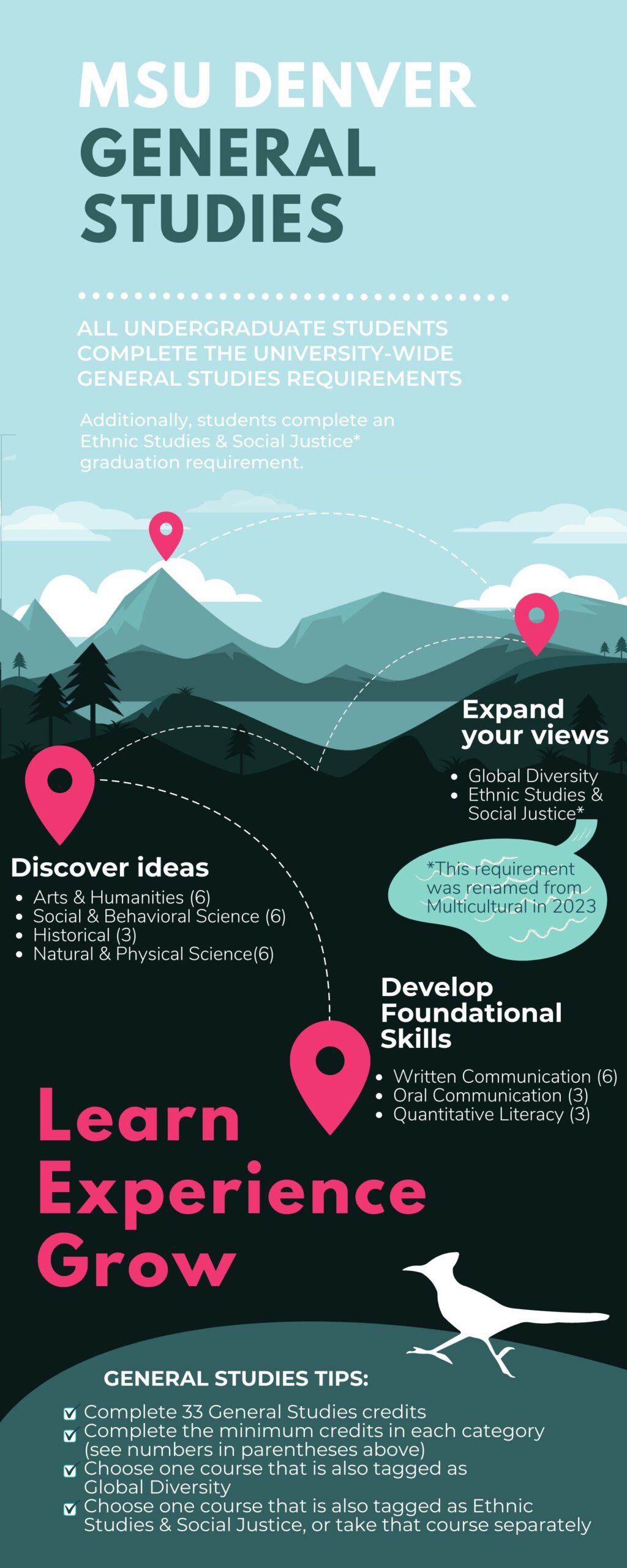Request Information
Ready to find out what MSU Denver can do for you? We’ve got you covered.
Faculty, please include the mission, description, and student learning outcomes for the category of your course in the Course Information Module’s Overview page. If your course is also GT Pathways, please also include that required language.
Mission:
The General Studies program provides the foundation for the Bachelor’s degree. Students develop thinking, reasoning, and communication skills while discovering new ideas and expanding their views. The coursework is designed to create the opportunity for learning across different disciplines and builds experiences for students as they grow into lifelong learners.

Description: Written communication is the development and expression of ideas in writing across many genres and styles. It includes understanding how writers may shape texts for their specific rhetorical situation. It includes multimodal composing and the creation of texts that combine words, images, and/or data. Written communication abilities develop through interactive and iterative experiences across the curriculum.
Student Learning Outcomes:
Description: Students learn to perform effective and ethical oral communication that is appropriate to diverse audiences, settings, media, and goals.
Student Learning Outcomes:
Description: Competency in quantitative literacy represents a student’s ability to use quantifiable information and mathematical analysis to make connections and draw conclusions. The main focus of each Quantitative Literacy course is the use of mathematical techniques and analysis, with problems from a broad spectrum of real-life and abstract settings requiring translation to and from mathematical forms.
Student Learning Outcomes: These are the same as before with one removed.
Description: In Arts and Humanities courses students interpret, analyze, and create texts and other artistic works to deepen their understanding of the various contexts that shape the human experience and explore fundamental questions of identity, value, diversity, and meaning.
Student Learning Outcomes:
Description: Historical thinking contextualizes the present by using a wide range of sources and methods to understand how people experienced the past.
Student Learning Outcomes (these are unchanged from the old, just renumbered):
Description: The Natural and Physical Sciences involve discovering knowledge in natural or physical sciences, applying scientific thinking and reasoning, and critically thinking about the use of scientific information.
Student Learning Outcomes:
Description: Global Diversity refers to a student’s ability to critically analyze and engage complex, interconnected global systems (such as natural, physical, social, cultural, economic, or political) and their implications for individuals, groups, communities, or cultures. These courses will introduce students to various concepts toward valuing diversity and the importance of inclusivity. Students should seek to understand how their actions affect both local and global communities. Courses in this category must contain a majority of material from one or more regions or countries outside the U.S.
Student Learning Outcomes:
The Ethnic Studies & Social Justice requirement replaced the Multicultural requirement for students on the 2023-2024 catalog and onward. The course lists for both are the same. Please always use the most recent course list, as courses are tagged with the attribute at the time you take them.
Students may find this requirement abbreviated on lists as ESSJ.
Ethnic Studies is rooted in a social justice approach to studying historically marginalized communities of color. The Ethnic Studies & Social Justice graduation requirement is designed to equip students with the tools to challenge, understand, and contextualize the treatment of racially and ethnically marginalized groups in the United States. As a fluid and contested space, the United States has been a historically, geographically, and politically contingent region. These courses center the experiences of marginalized groups and examine the ways in which the existences and experiences of these groups have been historically shaped by oppression and systems of white supremacy. Ethnic Studies & Social Justice coursework interrogates relationships between power, privilege, and oppression. Students explore how power and privilege in the past and present maintain oppression. Additionally, course content examines the resilience, activism, and advocacy of racially and ethnically marginalized groups to counter oppression and systems of white supremacy. Students learn to recognize key moments of liberation and those movements that advance social justice for racially and ethnically marginalized groups. Course content and materials may also examine and interrogate the oppression of other groups whose marginalized identities have been racialized and who have been thus oppressed as racial or ethnic minorities.
Students take one course that meets these goals. Students may take a course that fulfills this requirement AND a General Studies requirement.
Social and Behavioral Science
Description: Courses in Social and Behavioral Science study the behavior and actions of individuals, groups, and/or institutions using scientific methods and approaches. Social and Behavioral Science also develops a student’s ability to examine and influence those behaviors and actions between and among larger social, economic, political, and/or geographic contexts.
Student Learning Outcomes: